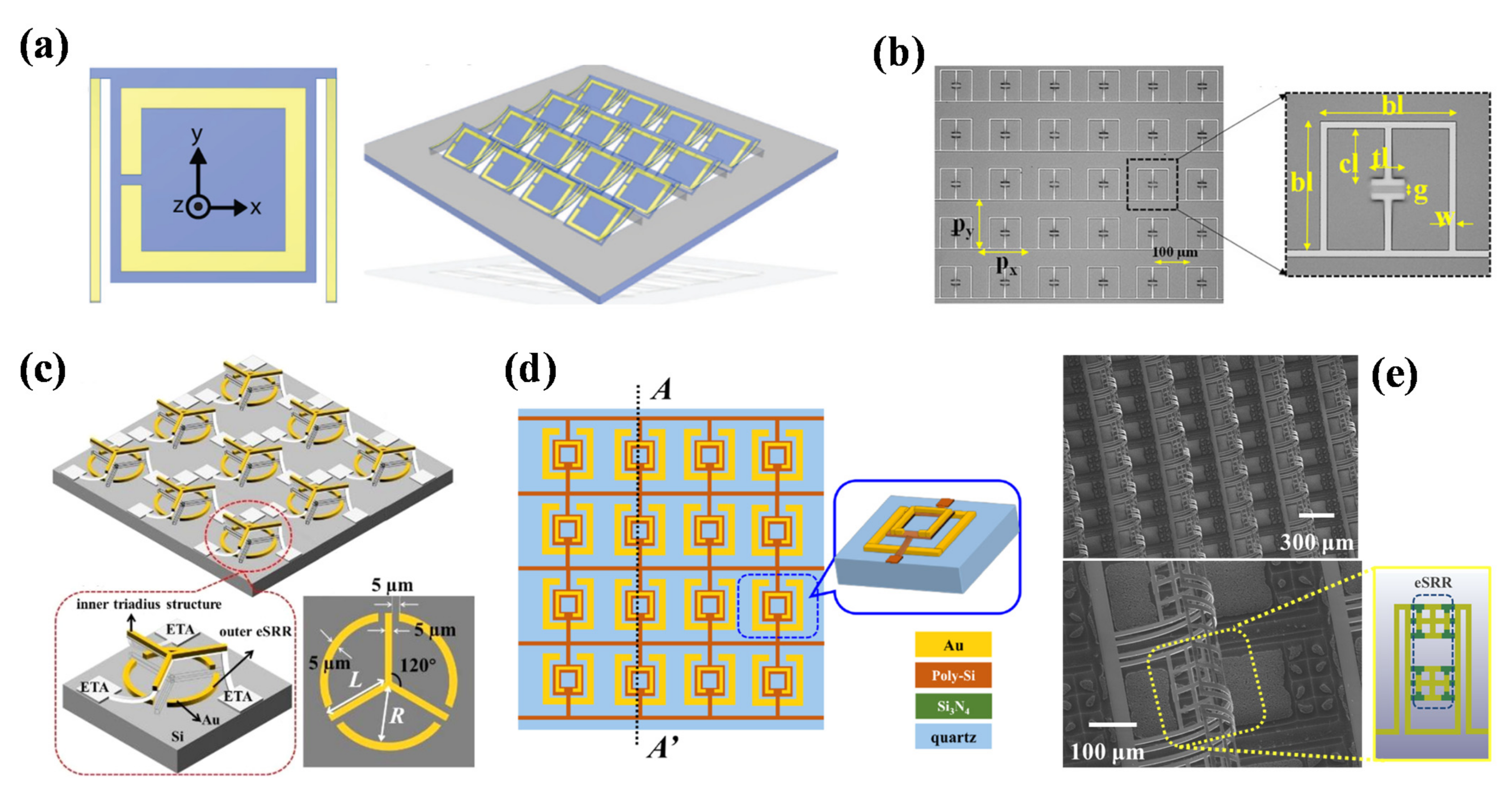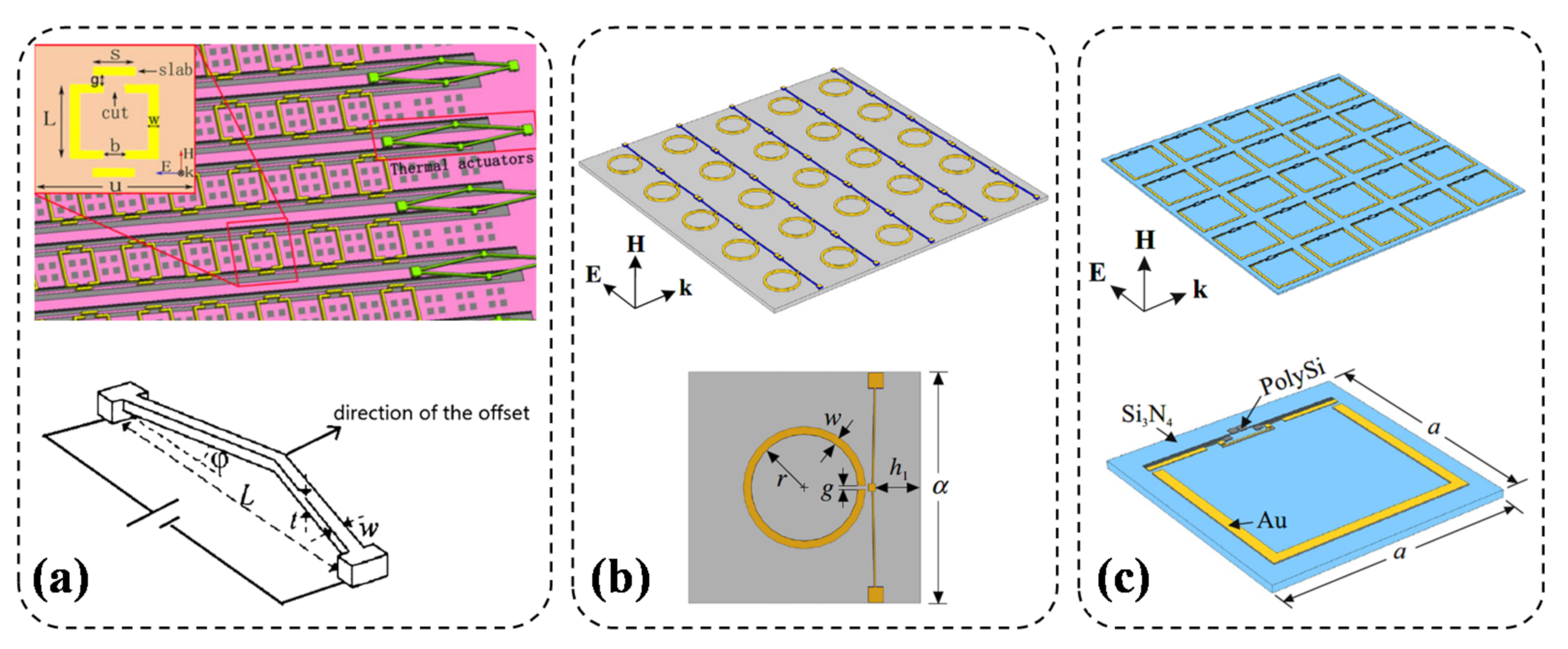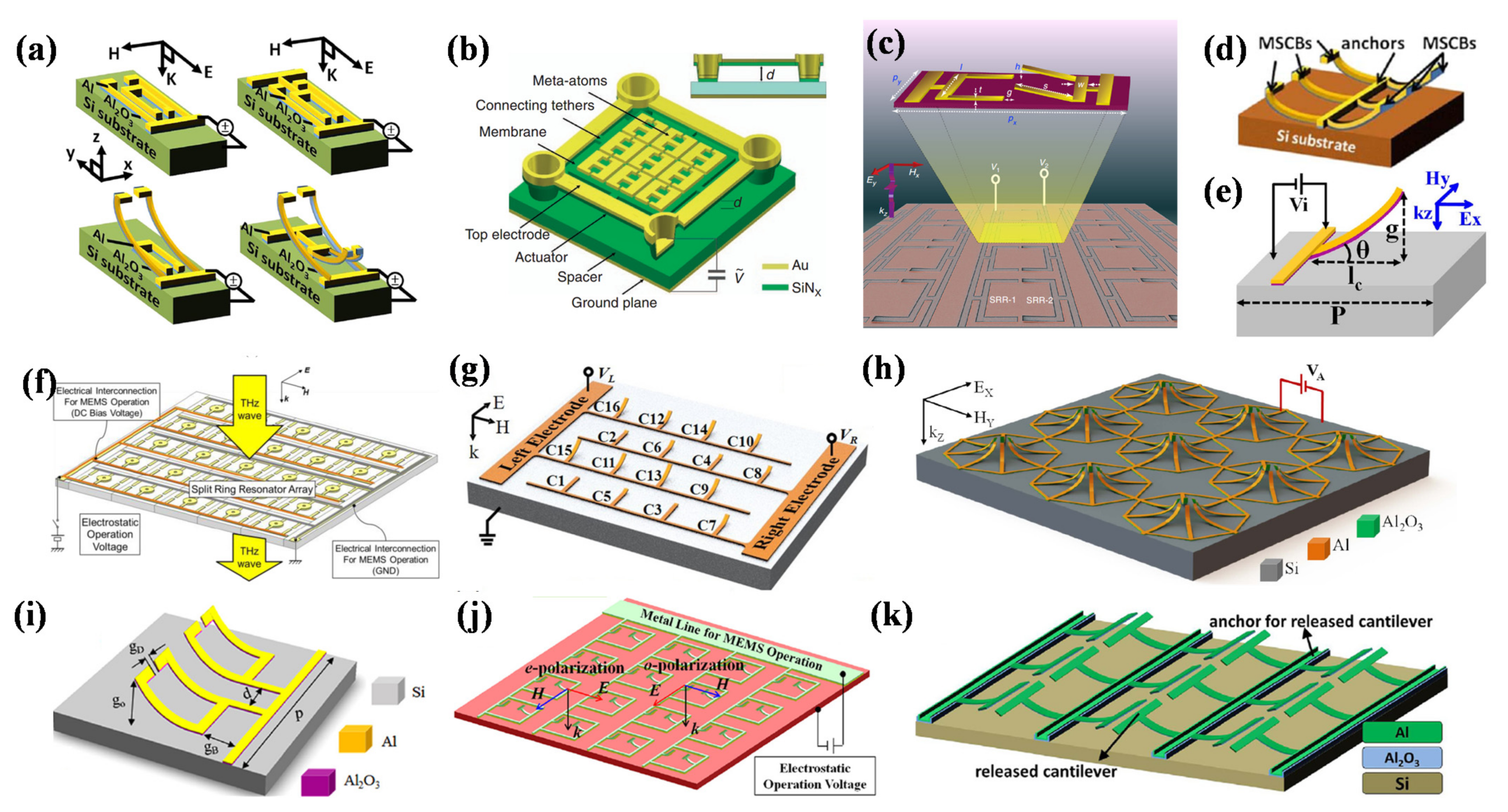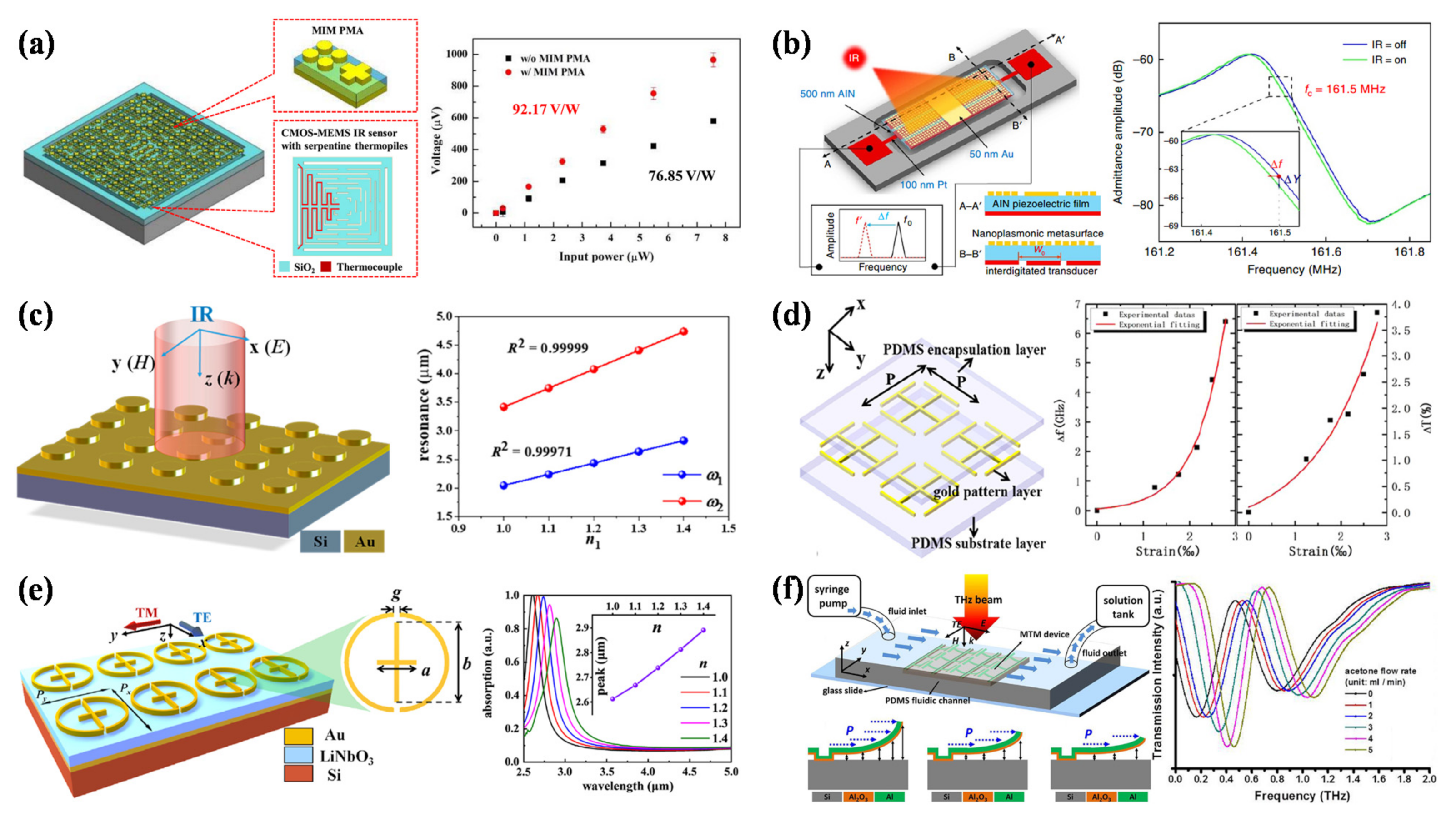Actively MEMS-Based Tunable Metamaterials for Advanced and Emerging Applications
Abstract
:1. Introduction
2. MEMS-Based Metamaterial Emerging
2.1. ETA-Based Metamaterial
2.1.1. Vertical Tuning Methods
2.1.2. Horizontal Tuning Methods
2.2. ESA-Based Metamaterial
2.2.1. Vertical Tuning Methods
2.2.2. Horizontal Tuning Methods
2.3. EMA-Based Metamaterial
2.4. Flexible Substrate-Based Metamaterial
2.5. Summary
3. Application
3.1. Logic Operation
3.2. Sensing
4. Conclusions
Author Contributions
Funding
Acknowledgments
Conflicts of Interest
References
- Smith, D.R.; Pendry, J.B.; Wiltshire, M.C.K. Metamaterials and negative refractive index. Science 2004, 305, 788–792. [Google Scholar] [CrossRef] [PubMed] [Green Version]
- Chen, H.T.; Padilla, W.J.; Zide, J.M.; Gossard, A.C.; Taylor, A.J.; Averitt, R.D. Active terahertz metamaterial devices. Nature 2006, 444, 597–600. [Google Scholar] [CrossRef] [PubMed] [Green Version]
- Schurig, D.; Mock, J.J.; Justice, B.J.; Cummer, S.A.; Pendry, J.B.; Starr, A.F.; Smith, D.R. Metamaterial electromagnetic cloak at microwave frequencies. Science 2006, 314, 977–980. [Google Scholar] [CrossRef] [Green Version]
- Cui, Y.; Fung, K.H.; Xu, J.; Ma, H.; Jin, Y.; He, S.; Fang, N.X. Ultrabroadband light absorption by a sawtooth anisotropic metamaterial slab. Nano Lett. 2012, 12, 1443–1447. [Google Scholar] [CrossRef] [PubMed] [Green Version]
- Fu, K.; Zhao, Z.; Jin, L. Programmable granular metamaterials for reusable energy absorption. Adv. Funct. Mater. 2019, 29, 1901258. [Google Scholar] [CrossRef]
- Le, D.H.; Lim, S. Four-mode programmable metamaterial using ternary foldable origami. ACS Appl. Mater. Interfaces 2019, 11, 28554–28561. [Google Scholar] [CrossRef]
- Li, W.; Guler, U.; Kinsey, N.; Naik, G.V.; Boltasseva, A.; Guan, J.; Shalaev, V.M.; Kildishev, A.V. Refractory plasmonics with titanium nitride: Broadband metamaterial absorber. Adv. Mater. 2014, 26, 7959–7965. [Google Scholar] [CrossRef]
- Ma, H.; Song, K.; Zhou, L.; Zhao, X. A naked eye refractive index sensor with a visible multiple peak metamaterial absorber. Sensors 2015, 15, 7454–7461. [Google Scholar] [CrossRef] [Green Version]
- Ni, X.J.; Wong, Z.J.; Mrejen, M.; Wang, Y.; Zhang, X. An ultrathin invisibility skin cloak for visible light. Science 2015, 349, 1310–1314. [Google Scholar] [CrossRef]
- Esposito, M.; Tasco, V.; Todisco, F.; Cuscuna, M.; Benedetti, A.; Scuderi, M.; Nicotra, G.; Passaseo, A. Programmable extreme chirality in the visible by helix-shaped metamaterial platform. Nano Lett. 2016, 16, 5823–5828. [Google Scholar] [CrossRef]
- Hossain, M.M.; Jia, B.; Gu, M. A metamaterial emitter for highly efficient radiative cooling. Adv. Opt. Mater. 2015, 3, 1047–1051. [Google Scholar] [CrossRef]
- Su, Z.; Yin, J.; Zhao, X. Soft and broadband infrared metamaterial absorber based on gold nanorod/liquid crystal hybrid with tunable total absorption. Sci. Rep. 2015, 5, 16698. [Google Scholar] [CrossRef] [PubMed] [Green Version]
- Dao, T.D.; Ishii, S.; Yokoyama, T.; Sawada, T.; Sugavaneshwar, R.P.; Chen, K.; Wada, Y.; Nabatame, T.; Nagao, T. Hole array perfect absorbers for spectrally selective midwavelength infrared pyroelectric detectors. ACS Photonics 2016, 3, 1271–1278. [Google Scholar] [CrossRef]
- Kim, J.; Han, K.; Hahn, J.W. Selective dual-band metamaterial perfect absorber for infrared stealth technology. Sci. Rep. 2017, 7, 6740. [Google Scholar] [CrossRef] [PubMed]
- Cong, L.; Xu, N.; Gu, J.; Singh, R.; Han, J.; Zhang, W. Highly flexible broadband terahertz metamaterial quarter-wave plate. Laser Photonics Rev. 2014, 8, 626–632. [Google Scholar] [CrossRef]
- Yang, K.; Liu, S.; Arezoomandan, S.; Nahata, A.; Sensale-Rodriguez, B. Graphene-based tunable metamaterial terahertz filters. Appl. Phys. Lett. 2014, 105, 093105. [Google Scholar] [CrossRef]
- Yao, G.; Ling, F.; Yue, J.; Luo, C.; Ji, J.; Yao, J. Dual-band tunable perfect metamaterial absorber in the THz range. Opt. Express 2016, 24, 1518–1527. [Google Scholar] [CrossRef]
- Wang, B.-X.; Wang, G.-Z. Temperature tunable metamaterial absorber at THz frequencies. J. Mater. Sci. Mater. Electron. 2017, 28, 8487–8493. [Google Scholar] [CrossRef]
- Huang, M.; Cheng, Y.; Cheng, Z.; Chen, H.; Mao, X.; Gong, R. Based on graphene tunable dual-band terahertz metamaterial absorber with wide-angle. Opt. Commun. 2018, 415, 194–201. [Google Scholar] [CrossRef]
- Liu, G.D.; Zhai, X.; Meng, H.Y.; Lin, Q.; Huang, Y.; Zhao, C.J.; Wang, L.L. Dirac semimetals based tunable narrowband absorber at terahertz frequencies. Opt. Express 2018, 26, 11471–11480. [Google Scholar] [CrossRef] [PubMed]
- Ding, F.; Cui, Y.; Ge, X.; Jin, Y.; He, S. Ultra-broadband microwave metamaterial absorber. Appl. Phys. Lett. 2012, 100, 103506. [Google Scholar] [CrossRef] [Green Version]
- Wu, Z.; Zhang, Z.L.; Chen, X.Q.; Feng, F.; Zhang, L.; Lv, Y.Y.; He, Y.Y.; Zou, Y.H. Microwave scattering-absorption properties of a lightweight all-dielectric coding metamaterial based on TiO2/CNTs. Opt. Lett. 2020, 45, 555–558. [Google Scholar] [CrossRef]
- Datta, S.; Mukherjee, S.; Shi, X.D.; Haq, M.; Deng, Y.M.; Udpa, L.; Rothwell, E. Negative index metamaterial lens for subwavelength microwave detection. Sensors 2021, 21, 4782. [Google Scholar] [CrossRef]
- Xu, J.; Fan, Y.C.; Su, X.P.; Guo, J.; Zhu, J.X.; Fu, Q.H.; Zhang, F.L. Broadband and wide angle microwave absorption with optically transparent metamaterial. Opt. Mater. 2021, 113, 110852. [Google Scholar] [CrossRef]
- Wang, Y.; Sun, T.; Paudel, T.; Zhang, Y.; Ren, Z.; Kempa, K. Metamaterial-plasmonic absorber structure for high efficiency amorphous silicon solar cells. Nano Lett. 2012, 12, 440–445. [Google Scholar] [CrossRef]
- Watts, C.M.; Liu, X.; Padilla, W.J. Metamaterial electromagnetic wave absorbers. Adv. Mater. 2012, 24, OP98–OP120. [Google Scholar] [CrossRef] [PubMed]
- Cong, L.; Cao, W.; Zhang, X.; Tian, Z.; Gu, J.; Singh, R.; Han, J.; Zhang, W. A perfect metamaterial polarization rotator. Appl. Phys. Lett. 2013, 103, 171107. [Google Scholar] [CrossRef]
- Withayachumnankul, W.; Jaruwongrungsee, K.; Tuantranont, A.; Fumeaux, C.; Abbott, D. Metamaterial-based microfluidic sensor for dielectric characterization. Sens. Actuators A Phys. 2013, 189, 233–237. [Google Scholar] [CrossRef] [Green Version]
- Yu-Sheng, L.; Chia-Yi, H.; Chengkuo, L. Reconfiguration of resonance characteristics for terahertz U-shape metamaterial using MEMS mechanism. IEEE J. Sel. Top. Quantum Electron. 2015, 21, 93–99. [Google Scholar] [CrossRef]
- Lochbaum, A.; Fedoryshyn, Y.; Dorodnyy, A.; Koch, U.; Hafner, C.; Leuthold, J. On-chip narrowband thermal emitter for Mid-IR optical gas sensing. ACS Photonics 2017, 4, 1371–1380. [Google Scholar] [CrossRef] [Green Version]
- Appavoo, K.; Haglund, R.F. Detecting nanoscale size dependence in VO2 phase transition using a split-ring resonator metamaterial. Nano Lett. 2011, 11, 1025–1031. [Google Scholar] [CrossRef]
- Wang, H.; Yang, Y.; Wang, L. Switchable wavelength-selective and diffuse metamaterial absorber/emitter with a phase transition spacer layer. Appl. Phys. Lett. 2014, 105, 071907. [Google Scholar] [CrossRef] [Green Version]
- Lei, L.; Lou, F.; Tao, K.Y.; Huang, H.X.; Cheng, X.; Xu, P. Tunable and scalable broadband metamaterial absorber involving VO2-based phase transition. Photonics Res. 2019, 7, 734–741. [Google Scholar] [CrossRef]
- Chen, P.-Y.; Alu, A. Terahertz metamaterial devices based on graphene nanostructures. IEEE Trans. Terahertz Sci. Technol. 2013, 3, 748–756. [Google Scholar] [CrossRef]
- Zhang, Y.; Li, T.; Chen, Q.; Zhang, H.; O’Hara, J.F.; Abele, E.; Taylor, A.J.; Chen, H.T.; Azad, A.K. Independently tunable dual-band perfect absorber based on graphene at mid-infrared frequencies. Sci. Rep. 2015, 5, 18463. [Google Scholar] [CrossRef] [Green Version]
- Li, H.; Wang, L.; Zhai, X. Tunable graphene-based mid-infrared plasmonic wide-angle narrowband perfect absorber. Sci. Rep. 2016, 6, 36651. [Google Scholar] [CrossRef] [PubMed] [Green Version]
- Zhang, J.; Wang, G.; Zhang, B.; He, T.; He, Y.; Shen, J. Photo-excited broadband tunable terahertz metamaterial absorber. Opt. Mater. 2016, 54, 32–36. [Google Scholar] [CrossRef]
- Shrekenhamer, D.; Chen, W.C.; Padilla, W.J. Liquid crystal tunable metamaterial absorber. Phys. Rev. Lett. 2013, 110, 177403. [Google Scholar] [CrossRef] [PubMed]
- Ou, J.Y.; Plum, E.; Zhang, J.; Zheludev, N.I. Giant nonlinearity of an optically reconfigurable plasmonic metamaterial. Adv. Mater. 2016, 28, 729–733. [Google Scholar] [CrossRef] [PubMed] [Green Version]
- Kim, J.; Jeong, H.; Lim, S. Mechanically actuated frequency reconfigurable metamaterial absorber. Sens. Actuators A Phys. 2019, 299, 111619. [Google Scholar] [CrossRef]
- Zhu, W.M.; Liu, A.Q.; Zhang, W.; Tao, J.F.; Bourouina, T.; Teng, J.H.; Zhang, X.H.; Wu, Q.Y.; Tanoto, H.; Guo, H.C.; et al. Polarization dependent state to polarization independent state change in THz metamaterials. Appl. Phys. Lett. 2011, 99. [Google Scholar] [CrossRef]
- Zhu, W.M.; Liu, A.Q.; Bourouina, T.; Tsai, D.P.; Teng, J.H.; Zhang, X.H.; Lo, G.Q.; Kwong, D.L.; Zheludev, N.I. Microelectromechanical Maltese-cross metamaterial with tunable terahertz anisotropy. Nat. Commun. 2012, 3, 1274. [Google Scholar] [CrossRef]
- Liu, X.; Padilla, W.J. Dynamic manipulation of infrared radiation with MEMS metamaterials. Adv. Opt. Mater. 2013, 1, 559–562. [Google Scholar] [CrossRef]
- Ho, C.P.; Pitchappa, P.; Lin, Y.-S.; Huang, C.-Y.; Kropelnicki, P.; Lee, C. Electrothermally actuated microelectromechanical systems based omega-ring terahertz metamaterial with polarization dependent characteristics. Appl. Phys. Lett. 2014, 104, 161104. [Google Scholar] [CrossRef] [Green Version]
- Pitchappa, P.; Ho, C.P.; Dhakar, L.; Lee, C. Microelectromechanically reconfigurable interpixelated metamaterial for independent tuning of multiple resonances at terahertz spectral region. Optica 2015, 2, 571–578. [Google Scholar] [CrossRef]
- Pitchappa, P.; Ho, C.P.; Cong, L.; Singh, R.; Singh, N.; Lee, C. Reconfigurable digital metamaterial for dynamic switching of terahertz anisotropy. Adv. Opt. Mater. 2016, 4, 391–398. [Google Scholar] [CrossRef]
- Liu, X.; Padilla, W.J. Reconfigurable room temperature metamaterial infrared emitter. Optica 2017, 4, 430–433. [Google Scholar] [CrossRef]
- Zhao, X.; Schalch, J.; Zhang, J.; Seren, H.R.; Duan, G.; Averitt, R.D.; Zhang, X. Electromechanically tunable metasurface transmission waveplate at terahertz frequencies. Optica 2018, 5, 303–310. [Google Scholar] [CrossRef]
- Xu, Z.; Lin, Y.S. A stretchable terahertz parabolic-shaped metamaterial. Adv. Opt. Mater. 2019, 7, 1900379. [Google Scholar] [CrossRef]
- Mo, Y.; Zhong, J.; Lin, Y.-S. Tunable chevron-shaped infrared metamaterial. Mater. Lett. 2020, 263, 127291. [Google Scholar] [CrossRef]
- Xu, R.; Lin, Y.S. Flexible and controllable metadevice using self-assembly MEMS actuator. Nano Lett. 2021, 21, 3205–3210. [Google Scholar] [CrossRef]
- Ou, J.Y.; Plum, E.; Jiang, L.; Zheludev, N.I. Reconfigurable photonic metamaterials. Nano Lett. 2011, 11, 2142–2144. [Google Scholar] [CrossRef]
- Pitchappa, P.; Ho, C.P.; Kropelnicki, P.; Singh, N.; Kwong, D.L.; Lee, C. Micro-electro-mechanically switchable near infrared complementary metamaterial absorber. Appl. Phys. Lett. 2014, 104, 201114. [Google Scholar] [CrossRef]
- Ivzhenko, L.; Odarenko, E.; Tarapov, S.I. Mechanically tunable wire medium metamaterial in the millimeter wave band. Prog. Electromagn. Res. 2016, 64, 93–98. [Google Scholar] [CrossRef] [Green Version]
- Liu, J.J.; Hong, Z. Mechanically tunable dual frequency THz metamaterial filter. Opt. Commun. 2018, 426, 598–601. [Google Scholar] [CrossRef]
- Morris, C.; Bekker, L.; Spadaccini, C.; Haberman, M.; Seepersad, C. Tunable mechanical metamaterial with constrained negative stiffness for improved quasi-static and dynamic energy dissipation. Adv. Eng. Mater. 2019, 21, 1900163. [Google Scholar] [CrossRef]
- Chen, F.Q.; Liu, X.J.; Tian, Y.P.; Zheng, Y. Mechanically stretchable metamaterial with tunable mid-infrared optical properties. Opt. Express 2021, 29, 37368–37375. [Google Scholar] [CrossRef] [PubMed]
- Tao, H.; Strikwerda, A.C.; Fan, K.; Padilla, W.J.; Zhang, X.; Averitt, R.D. Reconfigurable terahertz metamaterials. Phys. Rev. Lett. 2009, 103, 147401. [Google Scholar] [CrossRef] [PubMed] [Green Version]
- Pitchappa, P.; Manjappa, M.; Krishnamoorthy, H.N.S.; Chang, Y.; Lee, C.; Singh, R. Bidirectional reconfiguration and thermal tuning of microcantilever metamaterial device operating from 77 K to 400 K. Appl. Phys. Lett. 2017, 111, 261101. [Google Scholar] [CrossRef]
- Zhong, J.; Xu, X.; Lin, Y.-S. Tunable terahertz metamaterial with electromagnetically induced transparency characteristic for sensing application. Nanomaterials 2021, 11, 2175. [Google Scholar] [CrossRef]
- Yang, J.; Lin, Y.-S. Design of tunable terahertz metamaterial sensor with single- and dual-resonance characteristic. Nanomaterials 2021, 11, 2212. [Google Scholar] [CrossRef] [PubMed]
- Xu, R.; Xu, X.; Yang, B.-R.; Gui, X.; Qin, Z.; Lin, Y.-S. Actively logical modulation of MEMS-based terahertz metamaterial. Photonics Res. 2021, 9. [Google Scholar] [CrossRef]
- Li, X.; Yang, T.; Zhu, W.; Li, X. Continuously tunable terahertz metamaterial employing a thermal actuator. Microsyst. Technol. 2012, 19, 1145–1151. [Google Scholar] [CrossRef]
- Lalas, A.; Kantartzis, N.; Tsiboukis, T. Programmable terahertz metamaterials through V-beam electrothermal devices. Appl. Phys. A 2014, 117, 433–438. [Google Scholar] [CrossRef]
- Lalas, A.X.; Kantartzis, N.V.; Tsiboukis, T.D. Reconfigurable metamaterial components exploiting two-hot-arm electrothermal actuators. Microsyst. Technol. 2015, 21, 2097–2107. [Google Scholar] [CrossRef]
- Lin, Y.-S.; Qian, Y.; Ma, F.; Liu, Z.; Kropelnicki, P.; Lee, C. Development of stress-induced curved actuators for a tunable THz filter based on double split-ring resonators. Appl. Phys. Lett. 2013, 102, 111908. [Google Scholar] [CrossRef] [Green Version]
- Liu, M.; Susli, M.; Silva, D.; Putrino, G.; Kala, H.; Fan, S.; Cole, M.; Faraone, L.; Wallace, V.P.; Padilla, W.J.; et al. Ultrathin tunable terahertz absorber based on MEMS-driven metamaterial. Microsyst. Nanoeng. 2017, 3, 17033. [Google Scholar] [CrossRef] [Green Version]
- Manjappa, M.; Pitchappa, P.; Singh, N.; Wang, N.; Zheludev, N.I.; Lee, C.; Singh, R. Reconfigurable MEMS Fano metasurfaces with multiple-input-output states for logic operations at terahertz frequencies. Nat. Commun. 2018, 9, 4056. [Google Scholar] [CrossRef] [PubMed]
- Lin, Y.S.; Ma, F.; Lee, C. Three-dimensional movable metamaterial using electric split-ring resonators. Opt. Lett. 2013, 38, 3126–3128. [Google Scholar] [CrossRef]
- Pitchappa, P.; Ho, C.P.; Dhakar, L.; Qian, Y.; Singh, N.; Lee, C. Periodic array of subwavelength MEMS cantilevers for dynamic manipulation of terahertz waves. J. Microelectromech. Syst. 2015, 24, 525–527. [Google Scholar] [CrossRef]
- Zhengli, H.; Kohno, K.; Fujita, H.; Hirakawa, K.; Toshiyoshi, H. Tunable terahertz filter and modulator based on electrostatic MEMS reconfigurable SRR array. IEEE J. Sel. Top. Quantum Electron. 2015, 21, 114–122. [Google Scholar] [CrossRef]
- Shih, K.; Pitchappa, P.; Manjappa, M.; Ho, C.P.; Singh, R.; Yang, B.; Singh, N.; Lee, C. Active MEMS metamaterials for THz bandwidth control. Appl. Phys. Lett. 2017, 110, 161108. [Google Scholar] [CrossRef]
- Pitchappa, P.; Ho, C.P.; Qian, Y.; Dhakar, L.; Singh, N.; Lee, C. Microelectromechanically tunable multiband metamaterial with preserved isotropy. Sci. Rep. 2015, 5, 11678. [Google Scholar] [CrossRef] [PubMed] [Green Version]
- Pitchappa, P.; Manjappa, M.; Ho, C.P.; Qian, Y.; Singh, R.; Singh, N.; Lee, C. Active control of near-field coupling in conductively coupled microelectromechanical system metamaterial devices. Appl. Phys. Lett. 2016, 108, 111102. [Google Scholar] [CrossRef]
- Ma, F.; Qian, Y.; Lin, Y.-S.; Liu, H.; Zhang, X.; Liu, Z.; Ming-Lin Tsai, J.; Lee, C. Polarization-sensitive microelectromechanical systems based tunable terahertz metamaterials using three dimensional electric split-ring resonator arrays. Appl. Phys. Lett. 2013, 102, 161912. [Google Scholar] [CrossRef]
- Lin, Y.-S.; Lee, C. Tuning characteristics of mirrorlike T-shape terahertz metamaterial using out-of-plane actuated cantilevers. Appl. Phys. Lett. 2014, 104, 251914. [Google Scholar] [CrossRef]
- Schalch, J.; Duan, G.W.; Zhao, X.G.; Zhang, X.; Averitt, R.D. Terahertz metamaterial perfect absorber with continuously tunable air spacer layer. Appl. Phys. Lett. 2018, 113, 061113. [Google Scholar] [CrossRef]
- Liu, S.; Zhang, L.; Bai, G.D.; Cui, T.J. Flexible controls of broadband electromagnetic wavefronts with a mechanically programmable metamaterial. Sci. Rep. 2019, 9, 1809. [Google Scholar] [CrossRef] [Green Version]
- Wang, J.; Tian, H.; Wang, G.C.; Li, S.; Guo, W.P.; Xing, J.; Wang, Y.; Li, L.; Zhou, Z.X. Mechanical control of terahertz plasmon-induced transparency in single/double-layer stretchable metamaterial. J. Phys. D Appl. Phys. 2021, 54, 035101. [Google Scholar] [CrossRef]
- Fu, Y.H.; Liu, A.Q.; Zhu, W.M.; Zhang, X.M.; Tsai, D.P.; Zhang, J.B.; Mei, T.; Tao, J.F.; Guo, H.C.; Zhang, X.H.; et al. A micromachined reconfigurable metamaterial via reconfiguration of asymmetric split-ring resonators. Adv. Funct. Mater. 2011, 21, 3589–3594. [Google Scholar] [CrossRef]
- Zhu, W.M.; Liu, A.Q.; Zhang, X.M.; Tsai, D.P.; Bourouina, T.; Teng, J.H.; Zhang, X.H.; Guo, H.C.; Tanoto, H.; Mei, T.; et al. Switchable magnetic metamaterials using micromachining processes. Adv. Mater. 2011, 23, 1792–1796. [Google Scholar] [CrossRef] [PubMed]
- Wu, Z.; Wei Ming, Z.; Hong, C.; Tsai, M.L.J.; Guo-Qiang, L.; Din Ping, T.; Tanoto, H.; Jing-Hua, T.; Xin-Hai, Z.; Dim-Lee, K.; et al. Resonance switchable metamaterials using MEMS fabrications. IEEE J. Sel. Top. Quantum Electron. 2013, 19, 4700306. [Google Scholar] [CrossRef]
- Zhao, X.; Fan, K.; Zhang, J.; Keiser, G.R.; Duan, G.; Averitt, R.D.; Zhang, X. Voltage-tunable dual-layer terahertz metamaterials. Microsyst. Nanoeng. 2016, 2, 16025. [Google Scholar] [CrossRef] [Green Version]
- Huang, Y.; Nakamura, K.; Takida, Y.; Minamide, H.; Hane, K.; Kanamori, Y. Actively tunable THz filter based on an electromagnetically induced transparency analog hybridized with a MEMS metamaterial. Sci. Rep. 2020, 10, 20807. [Google Scholar] [CrossRef] [PubMed]
- Zhang, M.; Zhang, W.; Liu, A.Q.; Li, F.C.; Lan, C.F. Tunable polarization conversion and rotation based on a reconfigurable metasurface. Sci. Rep. 2017, 7, 12068. [Google Scholar] [CrossRef] [PubMed] [Green Version]
- Wen, Y.; Liang, Z.; Lin, Y.-S.; Chen, C.-H. Active modulation of polarization-sensitive infrared metamaterial. Opt. Commun. 2020, 463, 125489. [Google Scholar] [CrossRef]
- Xu, T.; Lin, Y.-S. Tunable terahertz metamaterial using an electric split-ring resonator with polarization-sensitive characteristic. Appl. Sci. 2020, 10, 4660. [Google Scholar] [CrossRef]
- Xu, T.; Xu, R.; Lin, Y.-S. Tunable terahertz metamaterial using electrostatically electric split-ring resonator. Results Phys. 2020, 19, 103638. [Google Scholar] [CrossRef]
- Xu, T.; Xu, X.; Lin, Y.-S. Tunable terahertz free spectra range using electric split-ring metamaterial. J. Microelectromech. Syst. 2021, 30, 309–314. [Google Scholar] [CrossRef]
- Zheludev, N.I.; Plum, E. Reconfigurable nanomechanical photonic metamaterials. Nat. Nanotechnol. 2016, 11, 16–22. [Google Scholar] [CrossRef] [Green Version]
- Kang, L.; Zhao, Q.; Zhao, H.J.; Zhou, J. Ferrite-based magnetically tunable left-handed metamaterial composed of SRRs and wires. Opt. Express 2008, 16, 17269–17275. [Google Scholar] [CrossRef] [PubMed]
- Cho, I.-J.; Yoon, E. A low-voltage three-axis electromagnetically actuated micromirror for fine alignment among optical devices. J. Micromech. Microeng. 2009, 19, 085007. [Google Scholar] [CrossRef]
- Ozbey, B.; Aktas, O. Continuously tunable terahertz metamaterial employing magnetically actuated cantilevers. Opt. Express 2011, 19, 5741–5752. [Google Scholar] [CrossRef] [PubMed] [Green Version]
- Khodasevych, I.E.; Shah, C.M.; Rowe, W.S.T.; Mitchell, A. Flexible fishnet metamaterial on PDMS substrate for THz frequencies. In Proceedings of the 2010 Conference on Optoelectronic and Microelectronic Materials and Devices, Canberra, Australia, 12–15 December 2010; pp. 25–26. [Google Scholar]
- Ling, K.; Kim, K.; Lim, S. Flexible liquid metal-filled metamaterial absorber on polydimethylsiloxane (PDMS). Opt. Express 2015, 23, 21375–21383. [Google Scholar] [CrossRef]
- Malek, S.C.; Ee, H.S.; Agarwal, R. Strain multiplexed metasurface holograms on a stretchable substrate. Nano Lett. 2017, 17, 3641–3645. [Google Scholar] [CrossRef] [Green Version]
- Li, J.; Shah, C.M.; Withayachumnankul, W.; Ung, B.S.Y.; Mitchell, A.; Sriram, S.; Bhaskaran, M.; Chang, S.; Abbott, D. Mechanically tunable terahertz metamaterials. Appl. Phys. Lett. 2013, 102, 012110. [Google Scholar] [CrossRef] [Green Version]
- Zhang, F.; Feng, S.; Qiu, K.; Liu, Z.; Fan, Y.; Zhang, W.; Zhao, Q.; Zhou, J. Mechanically stretchable and tunable metamaterial absorber. Appl. Phys. Lett. 2015, 106, 091907. [Google Scholar] [CrossRef]
- Kim, K.; Lee, D.; Eom, S.; Lim, S. Stretchable metamaterial absorber using liquid metal-filled polydimethylsiloxane (PDMS). Sensors 2016, 16, 521. [Google Scholar] [CrossRef] [Green Version]
- Ee, H.S.; Agarwal, R. Tunable metasurface and flat optical zoom lens on a stretchable substrate. Nano Lett. 2016, 16, 2818–2823. [Google Scholar] [CrossRef]
- Xu, R.; Luo, J.; Sha, J.; Zhong, J.; Xu, Z.; Tong, Y.; Lin, Y.-S. Stretchable IR metamaterial with ultra-narrowband perfect absorption. Appl. Phys. Lett. 2018, 113, 101907. [Google Scholar] [CrossRef]
- Zhang, H.; Feng, L.; Liang, Y.Z.; Xu, T. An ultra-flexible plasmonic metamaterial film for efficient omnidirectional and broadband optical absorption. Nanoscale 2019, 11, 437–443. [Google Scholar] [CrossRef]
- Gao, Z.Q.; Xu, C.L.; Tian, X.X.; Wang, J.F.; Tian, C.H.; Yang, B.Y.; Qu, S.B.; Fan, Q. Ultra-wideband flexible transparent metamaterial with wide-angle microwave absorption and low infrared emissivity. Opt. Express 2021, 29, 22108–22116. [Google Scholar] [CrossRef]
- Ahamed, E.; Faruque, M.R.I.; Alam, M.J.; Bin Mansor, M.F.; Islam, M.T. Digital metamaterial filter for encoding information. Sci. Rep. 2020, 10, 3289. [Google Scholar] [CrossRef]
- Cong, L.; Pitchappa, P.; Lee, C.; Singh, R. Active phase transition via loss engineering in a terahertz MEMS metamaterial. Adv. Mater. 2017, 29, 1700733. [Google Scholar] [CrossRef]
- Manjappa, M.; Pitchappa, P.; Wang, N.; Lee, C.; Singh, R. Active control of resonant cloaking in a terahertz MEMS metamaterial. Adv. Opt. Mater. 2018, 6, 1800141. [Google Scholar] [CrossRef]
- Xu, Z.; Lin, Z.; Cheng, S.; Lin, Y.S. Reconfigurable and tunable terahertz wrench-shape metamaterial performing programmable characteristic. Opt. Lett. 2019, 44, 3944–3947. [Google Scholar] [CrossRef] [PubMed]
- Zhu, F.; Lin, Y.-S. Programmable multidigit metamaterial using terahertz electric spilt-ring resonator. Opt. Laser Technol. 2021, 134, 106635. [Google Scholar] [CrossRef]
- Ho, C.P.; Pitchappa, P.; Lee, C. Digitally reconfigurable binary coded terahertz metamaterial with output analogous to NOR and AND. J. Appl. Phys. 2016, 119, 153104. [Google Scholar] [CrossRef]
- Lin, P.-S.; Shen, T.-W.; Chan, K.-C.; Fang, W. CMOS MEMS thermoelectric infrared sensor with plasmonic metamaterial absorber for selective wavelength absorption and responsivity enhancement. IEEE Sens. J. 2020, 20, 11105–11114. [Google Scholar] [CrossRef]
- Hui, Y.; Gomez-Diaz, J.S.; Qian, Z.; Alu, A.; Rinaldi, M. Plasmonic piezoelectric nanomechanical resonator for spectrally selective infrared sensing. Nat. Commun. 2016, 7, 11249. [Google Scholar] [CrossRef]
- Zhang, Y.; Lin, P.; Lin, Y.S. Tunable split-disk metamaterial absorber for sensing application. Nanomaterials 2021, 11, 598. [Google Scholar] [CrossRef]
- Zhao, X.; Yang, B.; Liu, J.; Pitchappa, P.; Hasan, D.; Ho, C.P.; Yang, C.; Lee, C. A multiband flexible terahertz metamaterial with curvature sensing functionality. J. Opt. 2016, 18, 075101. [Google Scholar] [CrossRef]
- Wen, Y.; Liang, Z.; Lin, Y.-S. Tunable perfect meta-absorber with high-sensitive polarization characteristic. Adv. Photonics Res. 2020, 2, 2000027. [Google Scholar] [CrossRef]
- Annamdas, V.G.M.; Soh, C.K. A perspective of non-fiber-optical metamaterial and piezoelectric material sensing in automated structural health monitoring. Sensors 2019, 19, 1490. [Google Scholar] [CrossRef] [PubMed] [Green Version]
- Wang, W.; Yan, F.P.; Tan, S.Y.; Li, H.S.; Du, X.M.; Zhang, L.N.; Bai, Z.Y.; Cheng, D.; Zhou, H.; Hou, Y.F. Enhancing sensing capacity of terahertz metamaterial absorbers with a surface-relief design. Photonics Res. 2020, 8, 519–527. [Google Scholar] [CrossRef]
- Du, X.M.; Yan, F.P.; Wang, W.; Zhang, L.N.; Bai, Z.Y.; Zhou, H.; Hou, Y.F. Thermally-stable graphene metamaterial absorber with excellent tunability for high-performance refractive index sensing in the terahertz band. Opt. Laser Technol. 2021, 144, 107409. [Google Scholar] [CrossRef]
- Gao, H.X.; Liang, Y.Z.; Yu, L.; Chu, S.W.; Cai, L.N.; Wang, F.; Wang, Q.; Peng, W. Bifunctional plasmonic metamaterial absorber for narrowband sensing detection and broadband optical absorption. Opt. Laser Technol. 2021, 137, 106807. [Google Scholar] [CrossRef]
- Liu, W.X.; Ma, Y.M.; Chang, Y.H.; Dong, B.W.; Wei, J.X.; Ren, Z.H.; Lee, C.K. Suspended silicon waveguide platform with subwavelength grating metamaterial cladding for long-wave infrared sensing applications. Nanophotonics 2021, 10, 1861–1870. [Google Scholar] [CrossRef]
- Yu, J.; Lang, T.T.; Chen, H.T. All-metal terahertz metamaterial absorber and refractive index sensing performance. Photonics 2021, 8, 164. [Google Scholar] [CrossRef]









| Actuation Type | Advantages | Disadvantages |
|---|---|---|
| ETA | Low driving voltage Large displacement | Slow response |
| ESA | Fast response Mature fabrication | Pull-in effect High driving voltage |
| EMA | Low driving voltage Large displacement | Need external magnets Electromagnetic interference |
| Stretching mechanism | Simple fabrication Large displacement Flexible, bendable | Need flexible substrate Incompatible to CMOS process |
Publisher’s Note: MDPI stays neutral with regard to jurisdictional claims in published maps and institutional affiliations. |
© 2022 by the authors. Licensee MDPI, Basel, Switzerland. This article is an open access article distributed under the terms and conditions of the Creative Commons Attribution (CC BY) license (https://creativecommons.org/licenses/by/4.0/).
Share and Cite
Xu, R.-J.; Lin, Y.-S. Actively MEMS-Based Tunable Metamaterials for Advanced and Emerging Applications. Electronics 2022, 11, 243. https://doi.org/10.3390/electronics11020243
Xu R-J, Lin Y-S. Actively MEMS-Based Tunable Metamaterials for Advanced and Emerging Applications. Electronics. 2022; 11(2):243. https://doi.org/10.3390/electronics11020243
Chicago/Turabian StyleXu, Rui-Jia, and Yu-Sheng Lin. 2022. "Actively MEMS-Based Tunable Metamaterials for Advanced and Emerging Applications" Electronics 11, no. 2: 243. https://doi.org/10.3390/electronics11020243
APA StyleXu, R.-J., & Lin, Y.-S. (2022). Actively MEMS-Based Tunable Metamaterials for Advanced and Emerging Applications. Electronics, 11(2), 243. https://doi.org/10.3390/electronics11020243






